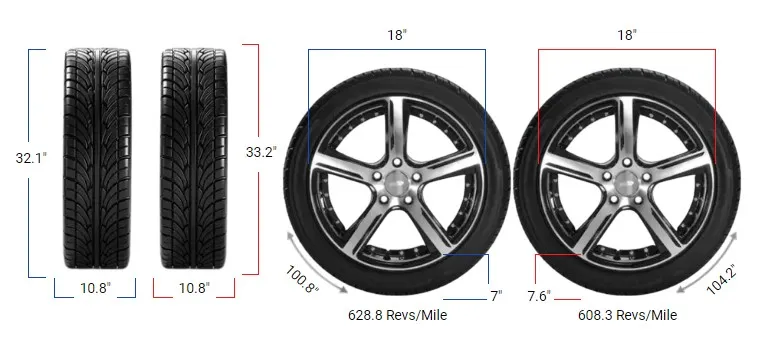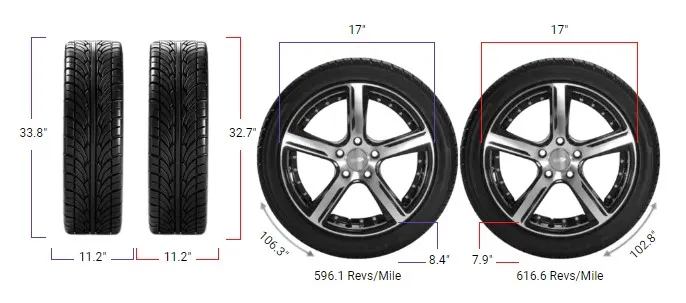Tire Size 225/65r17 vs 235/65r17

Tire upgrades can significantly impact your vehicle’s performance and appearance. Let’s explore the effects of switching from 225/65R17 to 235/65R17 tires, examining both benefits and potential drawbacks.
- Tire width increases by 0.39 inches for improved traction
- Overall diameter grows by 0.51 inches enhancing ground clearance
- Sidewall height rises by 0.26 inches potentially improving ride comfort
- Circumference expands by 1.61 inches affecting speedometer accuracy
- Revolutions per mile decrease by 12.47 impacting odometer readings
- Wider tires may slightly reduce fuel efficiency
- Larger tires can provide a more aggressive aesthetic appearance

Fitment Guide
The fitment guide indicates that the diameter difference between these tire sizes is within the acceptable 3% range.
With a 1.8% increase in diameter, the switch from 225/65R17 to 235/65R17 is considered safe and recommended for most vehicles.
On-Road Impact
The switch to 235/65R17 tires can affect various aspects of your vehicle’s on-road performance. Let’s examine these impacts:
- Handling: The wider tires offer improved grip and stability, especially during cornering. This can enhance your vehicle’s overall handling characteristics, particularly in dry conditions.
- Ride Comfort: The slightly larger sidewall (0.26 inches taller) may provide a marginal improvement in ride comfort, helping to absorb road imperfections more effectively.
- Gas Mileage: The wider tires may cause a slight decrease in fuel efficiency due to increased rolling resistance. However, the impact is likely to be minimal, typically less than 1 mpg.
- Speedometer Accuracy: The 1.8% increase in diameter will affect your speedometer reading. At 20 mph, your actual speed will be 20.36 mph, a difference of 0.36 mph. This small discrepancy is generally negligible for everyday driving but may be worth considering for long trips.
- Noise Levels: Wider tires may produce slightly more road noise, but the difference is often imperceptible to most drivers.

Off-Road Impact
For those who occasionally venture off the beaten path, the tire change can have some effects on off-road performance:
- Ground Clearance: The 0.51-inch (13mm) increase in diameter translates to a minimal 0.255-inch (6.5mm) gain in ground clearance. While this slight improvement may not be noticeable in most situations, it could provide a marginal benefit in off-road scenarios.
- Traction: The wider tires offer a larger contact patch, potentially improving traction on loose surfaces like gravel or mud. However, the difference may not be significant enough to dramatically alter off-road capabilities.
- Flotation: In soft terrain such as sand or snow, the wider tires may provide slightly better flotation, helping to prevent sinking and improving overall traction.
Aesthetics
The switch to wider tires can enhance your vehicle’s appearance:
- Muscular Look: The 10mm increase in width gives your vehicle a slightly more aggressive and muscular stance, which many drivers find appealing.
- Wheel Well Fill: The larger tires may better fill out your vehicle’s wheel wells, creating a more proportionate and visually pleasing look.

Durability & Wear
Tire durability and wear patterns may be affected by the size change:
- Tread Life: The larger contact patch of the wider tires may lead to slightly faster wear, but this effect is often negligible in real-world conditions.
- Even Wear: Proper alignment is crucial when switching to wider tires to ensure even wear and maximize tire life.
What is the Difference Between 225/65r17 and 235/65r17?
The primary difference lies in the tire width. The new 235/65R17 tires are 10mm (0.39 inches) wider than the original 225/65R17 tires, resulting in a 4.4% increase in width. This change can affect handling, traction, and overall vehicle aesthetics.
Can I Use 235/65r17 Instead of 225/65r17?
Yes, you can use 235/65r17 instead of 225/65r17. The diameter difference is 1.8%, which is within the recommended 3% limit for tire size changes. This makes the switch generally safe and compatible with most vehicles.
How Much Taller Is a 235/65r17 Tire Than a 225/65r17?
A 235/65r17 tire is 0.51 inches (13 mm) taller in diameter than a 225/65r17 tire. The overall diameter increases from 28.52 inches (724.3 mm) to 29.03 inches (737.3 mm), representing a 1.8% increase in height.
How Much Wider is a 235/65r17 Tire Than a 225/65r17?
A 235/65r17 tire is 0.39 inches (10 mm) wider than a 225/65r17 tire. The width increases from 8.86 inches (225 mm) to 9.25 inches (235 mm), which is a 4.4% increase in width.
225/65r17 vs 235/65r17 Chart
This table provides a detailed comparison of the 225/65R17 and 235/65R17 tire sizes.
| Feature | 225/65R17 | 235/65R17 | Difference |
|---|---|---|---|
| Diameter inches (mm) | 28.52 (724.3) | 29.03 (737.3) | 0.51 (13) +1.8% |
| Width inches (mm) | 8.86 (225) | 9.25 (235) | 0.39 (10) +4.4% |
| Circumference inches (mm) | 89.58 (2275.46) | 91.19 (2316.3) | 1.61 (40.84) +1.8% |
| Sidewall Height inches (mm) | 5.76 (146.25) | 6.01 (152.75) | 0.26 (6.5) +4.4% |
| Revolutions per mile (km) | 707.26 (439.47) | 694.79 (431.72) | -12.47 (-7.75) -1.8% |
| Speedo Reading | 20 mph | 20.36 mph | +0.36 mph |
Our Observation
Switching from 225/65R17 to 235/65R17 tires offers a blend of subtle improvements with minimal drawbacks. The wider tires provide enhanced grip and a more appealing look, while the slightly larger diameter maintains compatibility with vehicle systems.
On-road benefits include improved handling and marginally better ride comfort, though fuel efficiency may decrease slightly. Off-road performance sees minor improvements in ground clearance and traction.
The minimal impact on speedometer accuracy is negligible for most driving scenarios. Overall, this tire upgrade offers a balanced mix of performance and aesthetic enhancements without significant compromises, making it a worthwhile consideration for many drivers seeking a subtle yet effective vehicle upgrade.



